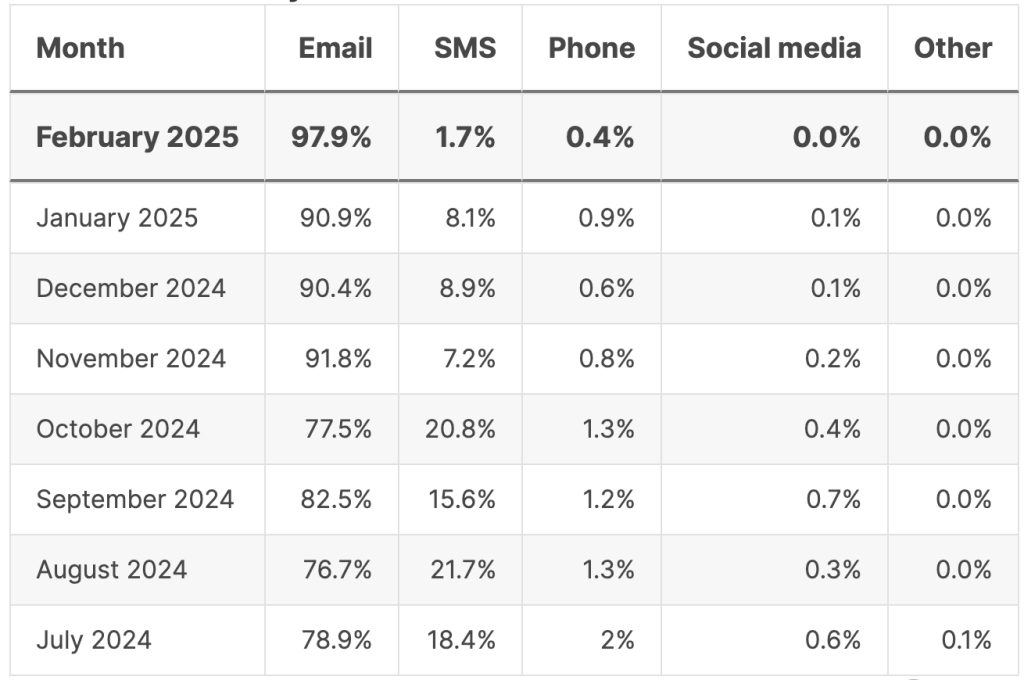
Telecom Scams in Australia
On a typical day, you get a text message on your phone. The message appears to be from an Australian postal agency, saying that there is an issue with one of your express packages, and asking you to click the link in the text message to fix the problem.
As you are trying to recall which express packages are being delivered recently, your phone rings again. You answer it in confusion, but what you heard was only an automated customer service message saying there is a problem with your bank account. Feeling panicked, you start looking for your ID to fix the issue. However, what you do not realize is that you have already fallen into the trap of multiple Internet telecom scams.
You may have never encountered the situation described above, but these problems are real part of life for many people around you. With the rapid development of Internet technology, online telecom scams have quietly become part of everyday life. They steal personal information and threaten financial security in ways that are hard to guard against. These scammers use people’s trust in familiar institutions and companies in daily life, such as banks and post offices, to steal millions of Australian dollars of assets from the public (McElroy & Mahe, 2024).

According to data from the Australian Taxation Office (ATO), ATO impersonation scam reports reached 7,537 in February 2025, a 30% increase from January (ATO, 2025). Among them, Email and SMS continued to be the primary channels used by scammers in February, making up 99.6% of all reported scams that month (ATO, 2025).
In many cases, people avoid falling victim to a scam yet —— not because they can easily recognise a scam, but simply because they have not encountered one that targets them personally.
How Australians Are Falling Victim to Telecom Scams
According to statistics, the state of Victoria has recorded more than 57,000 telecom scam cases in 2024, with total property losses expected to exceed AU$69 million (Singh, 2025). Behind these shocking figures are countless victims who have spent their lives working hard to save money. What causes these alarming numbers of scams in Australia?

One important factor for the rise in telecom scam cases is people’s increasing reliance on online technology and media platforms. More people are now relying heavily on the Internet, and sharing large amounts of personal information online without fully considering the risks. How data is collected is critical because it reveals the contradictions between privacy and power (Marwick & Boyd, 2018, p.1158). Many media companies often force users to choose to declare voluntarily share information in exchange for their services. However, in many cases, people do not fully understand what they are agreeing to, and they may not even realise their information is being collected (Marwick & Boyd, 2018, p.1158).
In the past, telecom scam scammers needed advanced tools and skills to access someone’s private information. However, now they can easily build detailed profiles only by browsing and accessing to others’ social media accounts on public platforms. These profiles may include a user’s gender, age, appearance, job and even home address. As personal information is becoming more transparent and visible on the Internet, it is also becoming easier for scammers to use.
Another important reason is the lack of responsibility in many media platforms or institutions in the governance and preventing scams. For example, media companies have almost absolute platform operation and control over the public media platforms they have created (Suzor, 2019, p.11).

Many victims who have suffered scams, such as bank-related scams, can only seek the help from the police after being scammed. However, not everyone can recover their lost property successfully. Scammers often use the credibility of banks, creating scams that are hard to distinguish. As a results, victims are left to face all the consequences and financial losses on their own. The rise in such scams has caused many people to concern the information management capabilities of online platforms. When using public online platforms, users should not only be cautious about protecting their personal information, but also stay alert to identify potential scam traps hidden among a large amount of online contents.
Aisha Dow and Charlotte Grieve pointed out that using Google search may bring a high risk of being scammed for Australians, due to its large number of scam websites and advertisements appearing in search results (Dow & Grieve, 2024). They found that there was a scam “industry chain” on Google, that is, after users lose money to scam advertisements placed by criminal teams, they are targeted again by fake services that claim to help recover their losses (Dow & Grieve, 2024).
Dan Halpin, head of the cyber fraud investigation company Cybertrace, said that Google, as one of the world’s most famous search engine platform, has shown a serious lack of due diligence when it comes to scam risks (Dow & Grieve, 2024).
With limited supervision and challenges in ensuring user information security, Internet platforms have undeniable responsibility for the current situation of telecom scams. In some cases, they may even be regarded as profiteers who also benefit from these scams.
Case Studies: International Students Become New Target for Scams in Australia

Since June 2023, three of Australia’s leading universities —— the University of Melbourne, the University of Sydney and the University of New South Wales —— have entered the top 20 of the global education rankings for the first time. The rising reputation of many Australian universities in the global education community has attracted more and more international students. However, the growth of Australia’s international education industry has also made international students a new target group for scammers.
A report released by the Australian National Anti-Scam Centre in September 2023 showed that the number of telecom scam cases involving scammers pretending to be police and targeting international students (especially Chinese students) has more than doubled compared with the past few months. According to statistics at the beginning of the same year, the total amount of money losses by telecom scams had even reached as high as AU$8,7 million (ScamWatch, 2023).
In September 2024, Stella, a Chinese student studying in Sydney, Australia, was accidentally involved in money laundering crimes as a result of an online scam, which eventually led to her Australian bank account being frozen and putting herself at serious legal risk (Zheng, 2024).
In this case, the scammers used the victim as a tool for money laundering, making the reason for “paying compensation and asking the victim to purchase goods locally in Australia” to attract her. Unaware of the scam, Stella became part of the criminal team. However, when Stella found out that her Australian bank account had been frozen, she was involved in another carefully planned scam in an attempt to resolve the issue —— the scammer pretended to be a Chinese police officer and asked her to return the money to the so-called “victim”.
Lennon Chang, a cybercrime and security expert at Deakin University, described the “combination of two frauds” that Stella encountered was a new type of scam emerging in Australia and was carefully organised by telecom scam teams (Zheng, 2024).
Australian ACCC Vice Chairman Catriona Lowe also pointed out that relevant Australian departments are more concerned about the increasing number of Chinese students suffering from telecom scams (Zheng, 2024).
In March of the same year, another telecom scam case involving international students in Western Australia also attracted public’s attention. In this case, the scammers stole the identity information of a 17-year-old Chinese student studying in Perth and pretended that he had been kidnapped, pressuring the victim’s family to pay a ransom of AU$215,000 (Thompson, 2024).
Scammers often send fake kidnapping videos and images to the victim’s parents through social media, using the victim’s personal contract information to scam their family and friends.
In the above two typical cases of international students falling victim to telecom scams in Australia, the scammers took advantage of the victims’ unfamiliarity with the life of studying abroad, their panic and anxiety, and their distance from families to manipulate them become part of these scams.
Australian Government Laws and Measures Against Telecom Scam
Although most telecom scam cases happen due to low awareness among victims, many public institutions and companies in Australia should also take more responsibility for protecting users’ online privacy and data security.
In February 2025, the Australian government passed the Scams Prevention Framework Act in Parliament, which is expected to be officially implemented in 2026 (Chakravarti, 2025). The newly passed legislation redefines the responsibilities and specific roles of banks, media companies and telecommunications operators in responding to the threat of telecom scams in Australia (Chakravarti, 2025).
The Scams Prevention Framework Act requires that in order to minimise the risk of telecom scams, the relevant major institutions must implement the following measures:
– Banks must verify the identity of the payees to ensure the security and transparency of financial transactions.
– Telecom companies are allowed to detect and block scam numbers used for malicious communications to prevent telecom scams at the source.
– Social media platforms have the responsibility to authenticate advertisers to prevent the spread of scam advertisements and contents.
According to the new law, the relevant institutions and companies that violate these measures and requirements may face fines of up to AU$50 million, or be required to pay compensation to specific victims of telecom scams (Chakravarti, 2025).
Advice from Australian Agencies on Dealing with Telecom Scams
Today, although telecom scam are an inevitable consequence of digital technology, they cannot be completely prevented. However, many institutions, including parts of the Australian government, local companies and Australian universities are working together to reduce telecom scam crimes and minimise their harmful impacts.
In response to the rise in Email and SMS scams in recent years, the Australian Communications and Media Authority (ACMA) provides all Australian people with clear and practical guidance on what to do when facing different types of scams or potential threats. The guidance include both preventive measures and immediate actions to take after being scammed. In addition, Australian government departments and police also encourage the public to regularly check official websites such as Scamwatch for the latest data reports and updates, helping people stay informed and aware of the emerging telecom scams.
If you suspect that you have been targeted by a telecom scam or are currently experiencing one, you can visit the following websites for help:
Australian Communications and Media Authority


Also, if you are an international student in Australia, here is some information that may help you:
- Top Scams in Australia in 2025 | International Students Watch Out
2. National Anti-Scam Centre warns of spike in scams threatening Chinese students
3. Scams Targeting Chinese Students by Department of Education Australian Government
Remember, being scammed is not your fault or something to be ashamed of. Do not let feelings of embarrassment or fear of being judged by family and friends lead to unnecessary self-blame. You can always seek help from your family, friends, or the police. If you happen to experience a telecom scam, just see it as a valuable lesson in your life. Everything will be okay.
References
Australian Taxation Office. (2025). Scam data. https://www.ato.gov.au/online-services/scams-cyber-safety-and-identity-protection/scam-data
Chakravarti, J. (2025, February 13). New Australian law makes Banks, Telecoms Liable for scams. Bank Info Security. https://www.bankinfosecurity.com/new-australian-law-makes-banks-telecoms-liable-for-scams-a-27516
Dow, A., & Grieve, C. (2024, November 18). The 101 ways Google serves up Australians to known scammers. Sydney Morning Herald. https://www.smh.com.au/business/consumer-affairs/the-101-ways-google-serves-up-australians-to-known-scammers-20241113-p5kqew.html
LTE Vlogs. (2025). Top scams in Australia in 2025 | International students Watch Out [Video]. YouTube. https://www.youtube.com/watch?v=LgHsf5cdrCs
Marwick, A. E., & Boyd, D. (2018). Understanding privacy at the margins: Introduction. International Journal of Communication. 1157–1165.https://go.gale.com/ps/i.do?p=AONE&u=usyd&id=GALE%7CA561120196&v=2.1&it=r&aty=shibboleth
McElroy, N., & Mahe, D. (2024, April 8). What is being done to crack down on text scammers in Australia? ABC News. https://www.abc.net.au/news/2024-04-08/what-is-being-done-to-combat-text-scammers-in-australia/103605166
ScamWatch. (2023). National Anti-Scam Centre warns of spike in scams threatening Chinese students. https://www.scamwatch.gov.au/about-us/news-and-alerts/national-anti-scam-centre-warns-of-spike-in-scams-threatening-chinese-students?utm_source=chatgpt.com
Singh, T. (2025, March 13). Police seek information after Foster woman scammed of $130,000. ABC News. https://www.abc.net.au/news/2025-03-13/police-seek-information-after-foster-woman-scammed/105045880
Suzor, N.P. (2019). Who Makes the Rules? In Lawless: The Secret Rules That Govern Our Digital Lives (pp. 10-24). Cambridge University Press. https://www.cambridge.org/core/books/lawless/8504E4EC8A74E539D701A04D3EE8D8DE
Thompson, H. (2024, June 3). WA international students ordered to fake own kidnappings in rising scams. Sydney Morning Herald. https://www.smh.com.au/national/western-australia/wa-international-students-ordered-to-fake-own-kidnappings-in-rising-scams-20240603-p5jiqk.html
Zheng, S. (2024, November 9). Chinese international students tricked into laundering scam victims’ money across borders. ABC News. https://www.abc.net.au/news/2024-11-09/new-scam-china-foreigners-chinese-international-student-victims/104537850

Be the first to comment